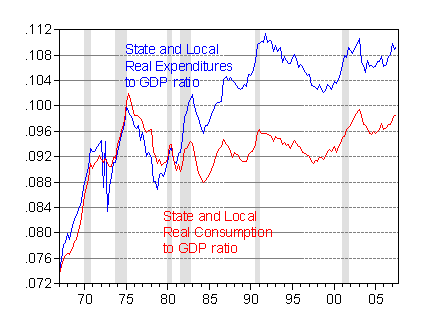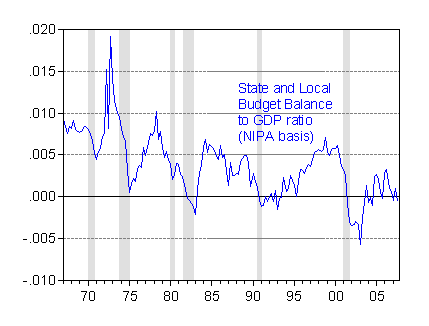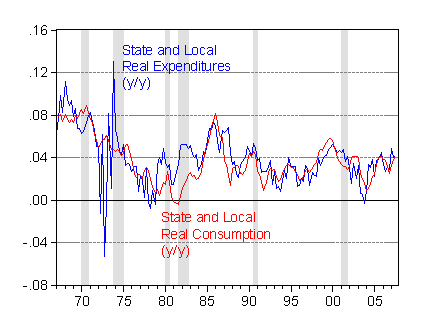Sudeep Reddy provides five reasonsWhy Economists Are Betting A Recession Won’t Happen. These reasons are ably summarized in the WSJ Real Time Economics Blog post Five Reasons Recession May Be Averted:
- The Fed is on the case.
The Fed, which has cut its main target for short-term interest rates by a full percentage point since August, is expected to ease rates through the middle of next year to cushion the economy from housing and credit woes, and officials are experimenting with new tools in an effort to ease the credit crunch and encourage banks to keep lending to worthy borrowers.
- Strong global growth is propping up the U.S. economy.
Global economic growth is raising demand for U.S. goods, offsetting softer domestic consumption. Emerging markets, which buy more than half of U.S. exports, continue to grow, some at an accelerating pace, even as industrialized economies cool.
- The economy is still creating jobs, supporting incomes.
The job market is signaling a modest slowdown in hiring but not a sharp increase in layoffs. While jobs continue to bleed from the housing and finance sectors, growth in service jobs remains robust and most other sectors remain afloat.
- The housing downturn’s pain will continue, but has already done much of its damage to growth.
One of the biggest questions hanging over the economy remains: How far is the housing market from its bottom? Though many major markets are experiencing steep price declines, much of the country is OK. The S&P/Case-Shiller index, a popular measure of home prices that has shown steep price declines, has limited geographic coverage — perhaps overstating the extent to which the housing sector’s declines will weigh on consumers.
- Government spending remains strong.
And then there is the government — not just Washington but state and local governments. Spending by state and local governments is contributing 25% of GDP growth this year — and that is before an election year when officials will resist making cutbacks. It tends to lag federal spending and should continue to perform well next year even if it slows in 2009, he says.
There’s plenty to discuss here, and some of it is well trodden ground. But I want to focus on the last point, which I hadn’t seen before, partly because I found it surprising.
State and local government spending, as I learned it in the macro textbooks, is procyclical. That’s because the borrowing capacity of state and local government is constrained, and with the advent of state balanced budget requirements, is increasingly constrained (although in principle state and local governments can save).
The following figures present the state and localspending shares of GDP (total expenditures, and consumption) on a NIPA basis, and the associated budget balance.
Figure 1: State and local government current expenditures (blue) and consumption (red), on a NIPA basis, as a share of nominal GDP. State and local spending calculated as the difference between total government and Federal series. NBER-defined recessions shaded gray. Source: BEA GDP release of 29 November 2007, Tables 3.1 and 3.2, NBER, and author’s calculations.
Figure 2: State and local government budget balance calculated as the difference between receipts and current expenditures, on a NIPA basis, as a share of nominal GDP. State and local spending calculated as the difference between total government and Federal series. NBER-defined recessions shaded gray. Source: BEA GDP release of 29 November 2007, Tables 3.1 and 3.2, NBER, and author’s calculations.
Figure 1 is interesting in that the spending ratio (either total or consumption) does does seem to rise in recessions. However, I would argue that that characterization arises in part because the denominator (nominal GDP) is declining. Figure 2 shows that state and local government budget balances quickly switched from surplus to deficit in 2000-01. While the deficits appear large, they are only half a percentage point of GDP at the peak (essentially a spike in 2003). Further, note that unlike 2000, there is no buffer. The combined state and local governments are near balance…
Returning to the expenditures side, another way of showing what happens to spending is to deflate spending, and calculate the year-on-year change (log differences). I use the GDP deflator (not because of any particular reason, just for simplicity). One can see that there is a wide diversity of experiences over the various recessions.
Figure 3: Year-on-year change in real state and local government current expenditures (blue) and consumption (red), on a NIPA basis. State and local spending calculated as the difference between total government and Federal series. GDP deflator used to convert to real terms. NBER-defined recessions shaded gray. Source: BEA GDP release of 29 November 2007, Tables 3.1 and 3.2, NBER, and author’s calculations.
I would argue that in the last recession, the real state and local spending (particularly consumption) was in part sustained because of spending associated with the post-9/11 security measures. That support is unlikely to be present should another recession occur.
Indeed, working in the opposite direction, one might imagine the procyclicality might be further exaggerated by the big surge in property taxes and fees associated with the housing boom. As that boom (both residential, and possibly commercial) further dissipates, one might anticipate a precipitous drop in state and local revenues and consequently spending. So, for my money, I’ll put more weight on the first four reasons.
Technorati Tags: state government spending,
local government spending,
procyclical spending,
housing boom,
GDP,
recession.



Menzie,
Interesting stuff. I was also a bit surprised when I read that wsj blog post. There was a related wsj article in Tuesday’s paper (p. A6 print):
http://online.wsj.com/article/SB119794186980635629.html
Basically lots of state & local gov’ts are seeing falling property tax revenues now or in the near future, while at the same time the effects of recent price increases are showing up with a lag in assessment values. The latter is prompting calls for freezes and/or reductions in property taxes in many areas.
Doesn’t seem like this will be much of a prop, really.
PS
As this blogger makes clear, CA just declared a fiscal emergency as a $4 billion surplus turned into a $14 billion deficit. CA will need to either raise taxes or cut spending. Neither is going to increase economic activity.
And as Californians like to remind everyone, where they go the rest of the US follows.
State and local expenditures are a lagging indicator. Government budgets are prepared well in advance of the fiscal period, which is always at least 12 months long and frequently 24 months. In contrast, consumers and businesses adjust their spending much more rapidly. Further, the need to political discussion about spending and taxation forces state and local governments to react slowly.
In simple terms, during a recession, the government is spending based on a budget developed during the boom. During the early part of the recovery, the government is spending based on the bust. Just a normal part of the business cycle.
What is consumption and how does it differ from expenditures?
Should we really be too confident in the other 4?
A lot of the chatter on CNBC (which I monitor throughout the day on XM radio) is that the Fed is behind in its easing.
The US economy is the driver of world economic growth, even today. Sadly, US consumers are not just the customers of last resort, they are the customers of first resort, and often the customers of only resort. The failure of countries as varied as Japan, Korea, China, and most of Europe to develop a consumer culture and use internal consumption to drive economic growth means that, if the US gets a cold, the world gets the flu.
More chatter on CNBC: jobs and incomes are a lagging indicator.
I’ve agreed with the 4th item for 6 months now! At what point do we get over the credit cruch? A stopped clock is right twice a day, and at some point #4 will come true, but has it come to pass? Has the housing market bottomed out? I’m losing my cool on that one.
Okay, maybe I need to change the channel from CNBC to music.
Some of those points are very odd.
Point 2 claims that global growth can keep the US economy afloat. Personal consumption is 70% of GDP and exports were about 11% of GDP for Q2 2007 according to the 2007 Q3 BEA report. We need exports to increase six times faster than personal consumption decreases to stay afloat.
Point 3 claims that jobs are still being created. First, jobs are probably not a leading indicator. Second, the rate of job creation has been below the rate of population growth.
Point 4 claims the Case-Shiller index has limited geographic coverage. This is pure garbage. The cities included in the 20-city index cover 96 million people according to the 2000 census, which is more than 1/3rd of all US residents. This is certainly better precision than your typical US poll or survey.
How did this get published?
#1: No doubt they are. How will it induce economic participants to increase leverage? Which participants?
#3: By the time a sharp fall-off in jobs and incomes arrives, we will already be well into a recession.
#4: The pace of house price declines has accelerated in recent months, so it is too early to gauge the impact on consumer spending. The second important variable is the impact of decreased availability of second lien loans on mortgage equity withdrawals.
Bill Conerly,
There is some lag in state and local budgets. But this is offset by the balanced budget rules most have on current balances. When the revenues stop coming in, they have to cut back, and right away. And as several have noted, alarm bells on revenues are already sounding in many states, many driven by the collapsing housing markets. We are hearing it hear in Virginia, with loud talk of all kinds of freezes coming, if not in the next six months, soon thereafter.
From the standpoint of people in state universities who are hiring, the word is “hire as soon as possible before the statewide freeze comes down.”
Regarding 3, aren’t new jobless claims back up in the mid-300K’s (four-week moving average) now? That is pretty high–highest since Katrina–and the trend isn’t good either. I don’t feel this is a strong argument against a recession.
Job creation is at a standstill. When the revisions come in, it will be like getting kicked in the groin.
There is a reason why the US citizen is so gloomy=no job creation-the job cuts.
Claims are rising because job creation has fallen under job destruction and more people are having to service claims. While job destruction has risen in recent months, not that much to force a 20-25000 increase in claims. Another surge in job cuts and a recession is a done deal. The event horizen will be passed and recession unavoidable.
VERY nervious time for this economy. Trend growth has ended and the future is not bright.
So Menzie given that GDP is not a “reliable” denominator here (#5) why doesn’t one (you) resort to the constant dollar amounts here that might show this decline, not increase, in government spending?
There is tons of infrastructure to do, but as others have pointed out with the current financial troubles, the funding?
Ok, that’s all the technicalities I can muster tonight…it’s that glow coming from Buzzy that he might change channels from CNBC that is some distraction…it could be the 2nd coming. It could.
The personal spending data for November give a pretty strong suggestion, assuming I’ve done the math right, that real spending in Q4 will be higher than in Q3. That was not what was generally expected. Even if real spending is a bit lower, that would be higher than had been expected. At the same time, the 3-month pace of rise in core inflation was 2.6%. Seeing a number like that, Fed hawks are going to dig in their heels. So the latest data show less slowing than expected, while inflation is running higher than will be tolerated. For a Fed that wants to deal wtih the real economy with the funds rate, the credit markets with other tools, today’s data represent a pretty good argument for TAF actions as far as the eye can see, but not for cutting the funds rate.
Here’s a URL which compares the OFHEO index and Case-Shiller:
http://www.ofheo.gov/media/research/notediff2.pdf
Apparently C-S does not cover 13 states and has major gaps in another 29.
Anony, the Case-Shiller is the respected (and established index for several years) measure on monitoring house prices…for good reasons that you could discern in a few minutes if you took a look at the actual document repleat with its methodology.
The OFHEO index has been around longer (housing sales since 1975) and has much broader coverage than Case-Shiller. Case-Shiller seems to be the preferred index for bears, I’ll grant you.
Rich and anonymous,
OFHEO doesn’t include nonconforming mortgages in its calculations. While it adds Idaho and Wisconsin, it loses most of California, New York, and Boston. Hmmm, which might be more important in terms of calculating losses due to a housing crash?